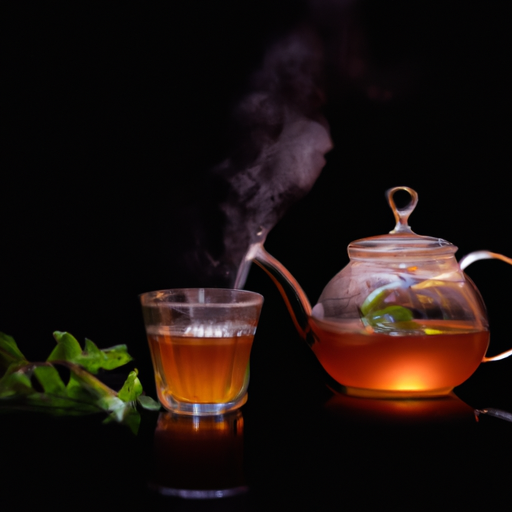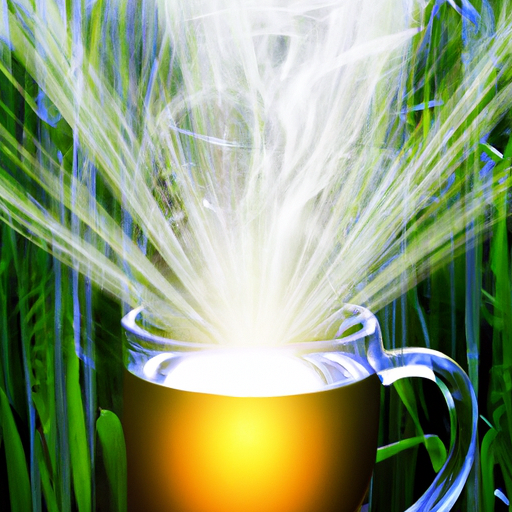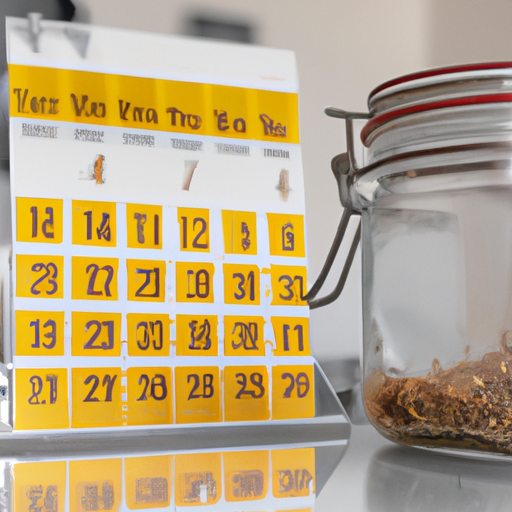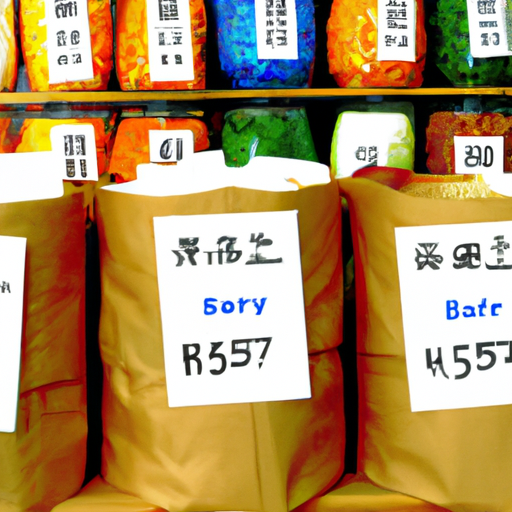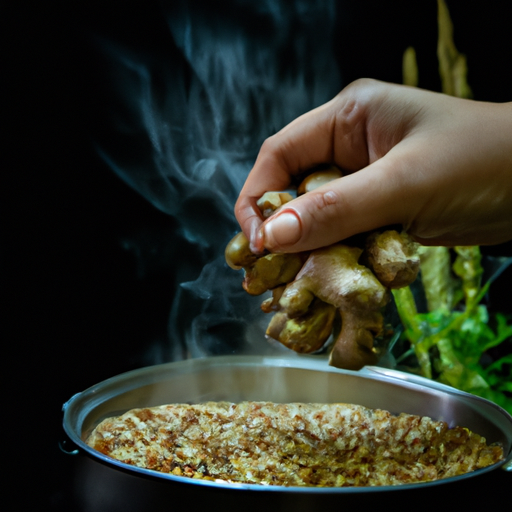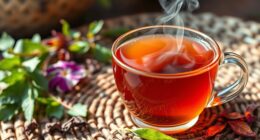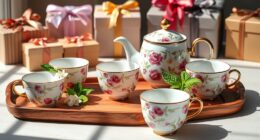I really enjoy a nice cup of tea, and roasted barley tea ranks high among my preferred choices. This traditional Korean beverage can be effortlessly prepared in the comfort of your home, offering a deep, nutty taste that makes it an ideal drink for enjoying during cool weather.
If you’re looking for something different from your usual cuppa, give this recipe a try. Roast barley tea is made from roasted barley grains, which have been dried and then toasted in the oven or over low heat until they’re dark brown. The result is a brew with a deep amber color and an earthy aroma.
It’s caffeine-free, so it won’t keep you up at night, and it has some potential health benefits too. Some people believe that roast barley tea can help aid digestion and boost the immune system.
So if you’re ready to try brewing your own batch of roast barley tea, let’s get started!
Key Takeaways
- Roast barley tea can be brewed using hot or cold infusion methods.
- Proper rinsing and roasting of high-quality barley grains is crucial for flavor and health benefits.
- Straining loose grains using a fine mesh strainer is necessary before serving.
- Roast barley tea has potential health benefits such as aiding digestion and boosting the immune system due to its antioxidant content.
What is Roast Barley Tea?
If you’re looking for a caffeine-free alternative to coffee or tea, you should try roast barley tea. This delicious drink is made from roasted barley grains and has a nutty, slightly sweet flavor that’s sure to satisfy.
Roast barley tea has a long history in Asia, where it’s been enjoyed for centuries. In many cultures, roast barley tea is more than just a tasty beverage – it’s also an important part of daily life.
In Korea and Japan, for example, it’s often served with meals or enjoyed as a refreshing pick-me-up throughout the day. In China, roast barley tea is believed to have medicinal properties and is used to treat ailments such as indigestion and colds.
One of the great things about roast barley tea is that it offers numerous health benefits. For starters, it’s naturally caffeine-free, which means you can enjoy it any time of day without worrying about disrupting your sleep patterns. It’s also rich in antioxidants and other beneficial compounds that can help promote overall health and well-being.
Benefits of Roast Barley Tea
Sipping on this warm, nutty elixir is like walking through a lush garden – each step revealing a new benefit for your body and mind. Roast barley tea has been enjoyed in Asian countries for centuries, not only for its delicious taste but also for its numerous health benefits. This tea contains antioxidants that can help fight against free radicals, which are known to damage cells and contribute to aging and diseases.
Roast barley tea is also believed to aid digestion and promote weight loss due to its high fiber content. Additionally, it may help regulate blood sugar levels, making it an excellent choice for those with diabetes or at risk of developing the condition. Its cultural significance in Asia cannot be overstated as it has become a staple beverage enjoyed by all ages.
To give you a better understanding of the many health benefits of roast barley tea, refer to the table below:
| Health Benefits | Description |
|---|---|
| Antioxidants | Fights against free radicals |
| Digestion Aid | High fiber content promotes healthy digestion |
| Weight Loss | May help control appetite and reduce calorie intake |
| Blood Sugar Regulation | May improve insulin sensitivity |
As you can see from the above table, roast barley tea offers various health benefits that make it an excellent addition to your daily routine. But before we delve into how to brew this flavorful drink, let’s first take a look at the necessary ingredients required.
Necessary Ingredients
To make this wholesome beverage, you’ll need a few simple ingredients that can be easily found in your local grocery store. Here are the necessary ingredients:
- Roasted barley: This is the key ingredient that gives the tea its distinctive nutty flavor and aroma. You can find it at most Asian grocery stores or online.
- Water: Use filtered water for best results.
- Sweetener (optional): Some people like to add honey or sugar to their barley tea for a touch of sweetness.
There are two main infusion methods for making roast barley tea: hot infusion and cold infusion. Hot infusion involves steeping roasted barley in hot water while cold infusion involves soaking it in cold water overnight. Both methods yield delicious, refreshing brews with their own unique flavors.
Roast barley tea is not only tasty but also packed with health benefits. It contains antioxidants that help fight free radicals in the body, as well as polyphenols which may reduce inflammation and improve heart health. Plus, it’s naturally caffeine-free, making it a great alternative to coffee or black tea.
To move on to the next step of brewing roast barley tea, you’ll need some equipment.
Equipment Needed
First, you’ll need some basic kitchen equipment to make this refreshing beverage. You will need a kettle to boil water and a strainer to sift out the tea leaves.
There are different types of kettles available in the market, such as electric and stovetop kettles. Electric kettles are convenient because they heat up quickly and have an automatic shut-off feature.
The temperature of water is crucial when brewing tea. For roasted barley tea, the ideal water temperature is around 200°F (93°C). If the water is too hot, it can burn the tea leaves and give a bitter taste; if it’s not hot enough, it won’t extract enough flavor from the barley grains.
You can measure the temperature with a thermometer or simply bring water to boil and let it cool for a few minutes before adding barley grains.
Now that we’ve covered all necessary equipment needed for making roasted barley tea, let’s move on to preparing the barley grains. We want to ensure that we use high-quality grain that has been rinsed thoroughly before brewing.
Preparing the Barley Grains
Before we can savor the unique taste of this traditional East Asian beverage, it’s essential to properly prepare the grains that give roasted barley tea its distinct flavor profile. The first step is to select high-quality barley grains from a trusted source. Once you have your grains, you need to rinse them thoroughly under cold running water to remove any dirt or debris.
After rinsing, you can begin soaking the grains. Soaking allows them to absorb water and become plump before roasting. There are two main soaking techniques you can use: overnight soaking or quick soaking. Overnight soaking involves immersing the grains in cold water for at least 8 hours, while quick soaking involves boiling the grains for a few minutes and then letting them sit in hot water for an hour.
Once you’ve soaked your barley grains, it’s time to roast them. Roasting methods vary depending on personal preference and cultural traditions. Some people prefer pan-roasting their barley over low heat until it turns golden brown and releases a nutty aroma, while others prefer oven roasting at 375°F for about 20-25 minutes until evenly browned. Regardless of which method you choose, make sure to stir the barley frequently during roasting to prevent burning.
Preparing the barley grains is just one step towards brewing a perfect cup of roasted barley tea. In the next section, we’ll explore how to brew this delicious beverage using our freshly roasted grains.
Brewing Roast Barley Tea
Now that the barley grains have been properly prepared, let’s dive into how to steep this deliciously nutty and comforting drink.
To brew roast barley tea, you’ll need to bring water to a boil in a pot or kettle. While waiting for the water to boil, grab about 1/4 cup of roasted barley grains per 2 cups of water.
Once the water has reached boiling point, add your desired amount of barley grains and reduce heat to medium-low. Allow the tea to simmer for about 5-10 minutes depending on your desired strength. Don’t worry if some of the grains float to the top – they will eventually settle at the bottom of your cup.
After brewing time is up, strain out any loose grains using a fine mesh strainer and pour into your favorite mug.
To enhance flavor, some people prefer using hot or cold water instead of boiling temperature water during brewing process but it’s completely optional. Additionally, you can adjust brewing time according to personal preference as well as adding sweeteners like honey or sugar before serving.
Now that you know how easy it is to brew roast barley tea with just a few simple steps, let’s explore different ways we can customize its flavor profile in our next section about ‘flavor variations’.
Flavor Variations
Get ready to tantalize your taste buds with a variety of mouth-watering flavors that will take your enjoyment of roast barley tea to the next level! One way to switch things up is by adjusting the sweetness and bitterness. For a sweeter flavor, add honey or sugar, while for a more bitter taste, increase the amount of roasted barley used in the brewing process.
Another factor to consider when varying the flavor of roast barley tea is whether to serve it hot or iced. The traditional method is to brew it hot and enjoy it as a warm beverage during colder months. However, as temperatures rise, iced roast barley tea can provide a refreshing break from the heat. Simply brew a large batch and let it cool down before pouring over ice.
Now that you know how to create different flavors and decide on serving temperature, it’s important to store your roast barley tea properly. To ensure maximum freshness and flavor retention, store in an airtight container in a cool, dark place away from any strong odors.
Enjoy this delicious drink whenever you need some cozy comfort or thirst-quenching refreshment!
Storing Roast Barley Tea
Just like a treasure chest, locking in the freshness and flavor of your beloved roasted barley drink requires proper storage. To maximize the shelf life of roast barley tea, make sure to store it in an airtight container that’s kept cool and away from strong odors. This will prevent moisture and air from seeping into the tea leaves, which can cause them to lose their flavor over time.
Here are some helpful tips for storing roast barley tea:
-
Keep it in an opaque container: Light can degrade the quality of roasted barley tea, so it’s best to store it in an opaque container that blocks out any light.
-
Store it separately from other teas: Roasted barley has a distinct flavor that may transfer to other types of teas if stored together.
-
Use a desiccant packet: If you live in a humid climate, consider using a desiccant packet to absorb any excess moisture inside the container.
-
Avoid freezing or refrigerating: While some people may think that keeping roast barley tea in the fridge or freezer will prolong its shelf life, this can actually cause condensation inside the container which will damage the tea leaves.
-
Check for freshness regularly: Even with proper storage techniques, roasted barley tea will eventually start to lose its flavor after several months. Be sure to check for freshness regularly and replace your stash if necessary.
Properly storing your roast barley tea is crucial not only for maintaining its delicious taste but also for ensuring its health benefits. Now that you know how to keep your favorite beverage fresh and flavorful, let’s move on to discussing some creative serving suggestions!
Serving Suggestions
When it comes to enjoying your favorite roasted barley tea, there are plenty of creative ways to serve it up! One of my favorite serving suggestions is to pair it with a light snack such as sliced fruit or crackers and cheese. This combination not only provides a delicious taste but also balances the flavors in your mouth.
Another great way to enjoy roast barley tea is by adding some honey or lemon for a sweeter taste. Honey goes perfectly with the nutty flavor of the roasted grains, while lemon adds a slightly tart touch that refreshes your palate. For those who prefer a creamy texture, adding milk can give you a unique flavor profile that’s perfect for breakfast or dessert.
Aside from its rich flavor, roast barley tea also boasts various health benefits. It’s rich in antioxidants and has been shown to improve digestion and lower cholesterol levels. Because of its caffeine-free nature, it’s also an excellent alternative for those who want to cut down on their coffee intake.
By incorporating this healthy drink into your daily routine, you can reap all its nutritional benefits while satisfying your cravings at the same time!
Frequently Asked Questions
Can roast barley tea be made with other types of grains besides barley?
I can’t stress enough how incredible it is to experiment with different grains when making roast barley tea! The possibilities for flavor variations are endless, as each grain offers its own unique taste and aroma.
Some alternative grains that work well for this tea include wheat, rye, and even corn. Wheat adds a nutty flavor while rye offers a slightly spicy note. Corn brings a mild sweetness to the mix.
By combining these grains with roasted barley, you can create an entirely new blend of tea that satisfies your taste buds in unexpected ways.
Is roast barley tea caffeine-free?
Roast barley tea is an excellent caffeine-free alternative to coffee or regular tea. It’s made by roasting barley grains until they turn dark brown, which gives the tea its nutty and toasty flavor.
The good news for those who are sensitive to caffeine is that roast barley tea contains no caffeine at all. It also has several health benefits, such as aiding digestion, improving blood circulation, and reducing inflammation in the body. Additionally, it’s rich in antioxidants and vitamins, making it a great choice for overall health and wellness.
So if you’re looking for a delicious and healthy beverage without the jitters of caffeine, try brewing roast barley tea today!
Can roast barley tea be sweetened with honey or other natural sweeteners?
When it comes to roast barley tea, you can definitely sweeten it with honey or other natural sweeteners! The nutty flavor of roasted barley pairs perfectly with the sweetness of honey.
If you’re looking for alternatives to honey, try using maple syrup or agave nectar. Another great way to enhance the flavor of your roast barley tea is by adding a touch of cinnamon or ginger. These spices complement the earthy taste of the tea and give it an extra kick.
So go ahead and experiment with different flavors until you find your perfect combination – there’s no limit to how creative you can get when brewing this delicious and healthy beverage!
How long can roast barley tea be stored in the refrigerator?
When it comes to storing roast barley tea, refrigeration is key. By keeping the tea in an airtight container and placing it in the refrigerator, you can extend its shelf life and preserve its freshness.
The general rule of thumb is that roasted barley tea can last for up to one week when stored properly in the fridge. However, it’s important to note that this timeline may vary depending on the quality of ingredients used and the conditions in which the tea was stored.
To ensure that your roast barley tea stays fresh as long as possible, be sure to check for any signs of spoilage or expiration date before consuming.
Are there any potential health risks associated with drinking roast barley tea?
After doing some research, I’ve found that there are potential health risks associated with drinking roast barley tea.
Roasting barley can cause the formation of toxic compounds called acrylamides. These compounds have been linked to cancer and other health issues.
Additionally, people with allergies to gluten or barley should avoid drinking this tea.
It’s important to note that while green tea has its own health benefits, such as containing antioxidants and promoting weight loss, it’s not a direct substitute for roast barley tea.
Overall, it’s best to consume roast barley tea in moderation and be aware of any potential allergic reactions or negative effects on one’s health.
Conclusion
In conclusion, brewing roast barley tea is a simple and rewarding process that can be enjoyed both for its taste and health benefits. By using quality ingredients and equipment, you can elevate the flavor profile of your tea and experiment with different variations to suit your preferences.
Whether you prefer a stronger or milder taste, adding honey or lemon, or enjoying it hot or cold, there are endless ways to customize your brew. At the same time, it’s important not to overlook the potential risks associated with consuming large amounts of roasted barley.
While this tea has been traditionally used for centuries in many cultures as a natural remedy for various ailments, excessive intake may lead to negative side effects such as stomach upset or allergic reactions. Therefore, it’s recommended to consult with a healthcare provider before incorporating roast barley tea into your daily routine.
Overall, brewing roast barley tea offers a unique opportunity to connect with nature through its rich aroma and earthy flavors while also promoting wellness. So why not give it a try? Who knows – you might discover a new favorite drink that’ll help you unwind after a long day or boost your energy levels when needed!

